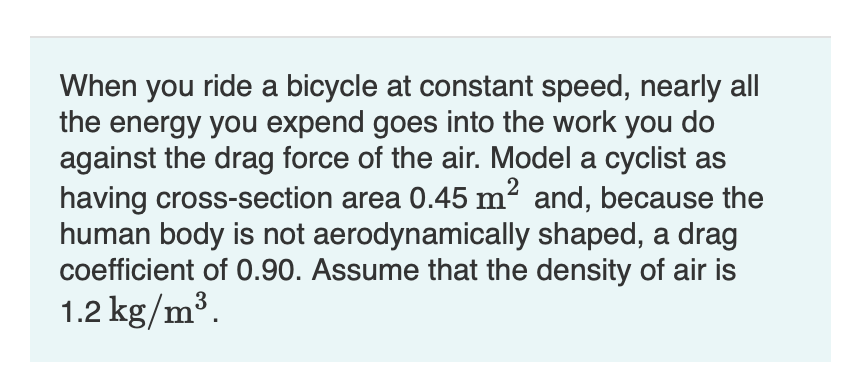When you ride a bicycle at constant speed, nearly all the energy you expend goes into the work you do against the drag force of the air. Model a cyclist as having cross-section area 0.45 m² and, because the human body is not aerodynamically shaped, a drag coefficient of 0.90. Assume that the density of air is 1.2 kg/m³. 2 3
When you ride a bicycle at constant speed, nearly all the energy you expend goes into the work you do against the drag force of the air. Model a cyclist as having cross-section area 0.45 m² and, because the human body is not aerodynamically shaped, a drag coefficient of 0.90. Assume that the density of air is 1.2 kg/m³. 2 3
Related questions
Question
100%
a)What is the cyclist's power output while riding at a steady 6.3 m/s (13.8 mph)?
Express your answer with the appropriate units.
b)Metabolic power is the rate at which your body "burns" fuel to power your activities. For many activities, your body is roughly 25%efficient at converting the chemical energy of food into mechanical energy. What is the cyclist's metabolic power while cycling at 6.3 m/s?
Express your answer with the appropriate units.
c)The food calorie is equivalent to 4190 J. How many Calories does the cyclist burn if he rides over level ground at 7.3 m/s for 1.0 h?
Express your answer in Calories.

Transcribed Image Text:When you ride a bicycle at constant speed, nearly all
the energy you expend goes into the work you do
against the drag force of the air. Model a cyclist as
having cross-section area 0.45 m² and, because the
human body is not aerodynamically shaped, a drag
coefficient of 0.90. Assume that the density of air is
3
1.2 kg/m³.
Expert Solution
This question has been solved!
Explore an expertly crafted, step-by-step solution for a thorough understanding of key concepts.
This is a popular solution!
Trending now
This is a popular solution!
Step by step
Solved in 2 steps with 2 images
